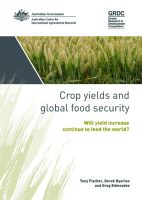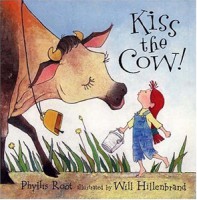This list was compiled by Victoria Taylor, Director of Flourish Communication, who is currently reading “Empires of Food: Feast, Famine and the Rise and Fall of Civilizations” by Evan D. C. Fraser and Andrew Rimas. Follow Victoria on Twitter
We asked a diverse group of people working in agriculture to nominate books that showcase the importance of agriculture to our lives. From children’s books, rural histories, government policy and management manuals, the selection is as diverse as the contributors. Food and fibre. Where would humanity be without them? Nowhere.
Enjoy this list.
 1. Crop Yields and Global Food Security: will yield increase continue to feed the world? by Tony Fischer, Derek Byerlee and Greg Edmeades
1. Crop Yields and Global Food Security: will yield increase continue to feed the world? by Tony Fischer, Derek Byerlee and Greg Edmeades
http://aciar.gov.au/publication/mn158
“This is the most comprehensive account of world agronomy that we have ever had available. At 600 pages it was somewhat daunting to start, but it took no time to be fully absorbed in not only the detail of the information, but the simplicity of the presentation. The book provides substantial chapters on the ‘big 4’ world crops being rice, wheat, maize and soybeans and lesser but informative coverage of other crops. It explores yield performance of individual crops and the trends in potential yield and farm yield. The genetic, physiological, agronomic and socioeconomic factors behind the yield increases are considered and described. The on-farm constraints are evaluated, as are the prospects for closing the gap between potential yield and farm yield. Key issues are then considered including water use efficiency, nutrient use efficiency, sustainability and total factor productivity. Prospects for yield improvements also make for interesting and challenging reading. For a complex topic the book is easy to read and the presentation is outstanding. If only it were available when I was starting my career as an agronomist many years ago I may have made better decisions along the way.”
Professor James Pratley is the Professor of Agriculture at Charles Sturt University and Secretary of the Australian Council of Deans of Agriculture. Follow Jim on Twitter
 2. The Art and Science of Shepherding edited by Michel Meuret and Fred Provenza
2. The Art and Science of Shepherding edited by Michel Meuret and Fred Provenza
http://www.acresusa.com/the-art-science-of-shepherding
“The book shows how expert shepherding is profoundly science-based, but without reference to the language and methods of science. Over three decades, researchers have studied shepherding and found it can often be a more effective use of landscapes than more intentionally science-based forms of agriculture. As the “art” in the title signals, the authors also pay attention to how creative interactions between people, animals and landscapes can deliver much more subtle outcomes than might be possible with the blunt instrument of science. To me, this was a fascinating book that opens up many questions about livestock and landscape management, particularly in the Australian rangelands.”
Matthew Cawood is the national beef industry writer and science and environment writer for Fairfax Agricultural Media. Read his full review of this book. Follow Matt on Twitter. http://www.farmonline.com.au/news/agriculture/livestock/general-news/training-livestock-for-landscapes/2696102.aspx?storypage=0
 3. Kiss the Cow by Phyllis Root and illustrated by Will Hillenbrand
3. Kiss the Cow by Phyllis Root and illustrated by Will Hillenbrand
http://www.scholastic.com/teachers/book/kiss-cow#cart/cleanup
“As the end note explains: “Annalisa milks Mama May’s magic cow but won’t kiss her and – no kiss, no milk. Will Annalisa’s family go hungry? Or will Annalisa finally kiss the cow?” This endearing children’s book about the relationships between animals, farmer and anyone who knows the squeak of fresh cheese illustrates the love of animals that runs deep in the farmer psyche.”
Marian McDonald is a dairy farmer in Gippsland, Victoria. She also writes the popular blog The Milk Maid Marian, about her life as a farmer. Follow Marian on Twitter
 4. Feeding the Ten Billion, Plants and Population Growth by L. T Evans
4. Feeding the Ten Billion, Plants and Population Growth by L. T Evans
“This is an excellent book written by a distinguished scientist who worked for many years for CSIRO. He was a Rhodes Scholar. It gives an excellent view of the development of world agriculture and in fact civilisation as we know it. It was through agriculture that humans could settle and then create wealth and specialisation of labour etc. etc.”
 5. The House on the Hill: the transformation of Australian farming communities by Neil Barr
5. The House on the Hill: the transformation of Australian farming communities by Neil Barr
http://lwa.gov.au/products/pn20461
“This is written by well-known rural Social Researcher, Neil Barr who is based in Bendigo. It provides an excellent overview of how rural communities have changed during the 20th Century. It is more than agriculture but it is impossible to delineate where agriculture starts and where rural communities commence!”
 6. Breaking the Sheep’s Back: The shocking true story of the decline and fall of the Australian wool industry by Charles Massy
6. Breaking the Sheep’s Back: The shocking true story of the decline and fall of the Australian wool industry by Charles Massy
http://www.uqp.uq.edu.au/book.aspx/1142/Breaking%20the%20Sheep
“This is a very interesting book depicting the disasters of the wool industry in the late 20th Century. It gives a real insight as to how regulation of primary industries can go horribly wrong.”
7. Manangatang by Adam McNicol
http://www.bookshop.vic.gov.au/local-histories-melbourne-manangatang-p-102552.html
“This is a local history of the settlement of a locality in the Mallee Region of Victoria. It is as much a social history as an agricultural history but it gives a valuable insight into the growth and development and subsequent decline of a country town in regional Victoria. It may be hard to get as it is not produced by a large publisher. It has been written by Adam McNicol, a journalist who grew up on a wheat and sheep farm at Manangatang. The book’s production was timed to celebrate the town’s centenary but it is more than a glib centenary publication.”
Dr Cameron Archer, Principal of the NSW Department of Primary Industries’ Tocal College and Chair of the Primary Industries Education Foundation nominated these four books.
8. The Murray-Darling Basin Plan by Commonwealth of Australia
http://www.comlaw.gov.au/Details/F2012L02240
“If there’s one resource that agriculture critically depends on it is water. It is in scarce supply and fiercely contested world-wide. That has long been the case in Australia, where water reform in Australia’s most productive river basin, the Murray-Darling, has been a hard slog. After a century of increasing diversions to agriculture, restoring water to the environment at the expense of irrigators has proven contentious and costly. It’s not often books are burnt these days in Australia, but that is exactly what farmers did to the draft guide to the Basin Plan as a measure of their contempt. So my nomination for a great book about agriculture is the phoenix-like Basin Plan – the blueprint for ecologically sustainable development of Australia’s most important agricultural region. Its significance is that it sets out a way to re-balance the water needs of agriculture and the environment, sensitive to the needs of the community. In doing so, it is not just a blueprint for the driest continent, but for all of them!”
Dr Peter O’Brien is the Director of the Murray-Darling Basin Futures Collaborative Research Network at the University of Canberra.
9. Holistic Management; A new framework for decision making by Allan Savory
http://www.amazon.com/Holistic-Management-Framework-Decision-Making/dp/155963488X
“This book is centred on philosophies and principles that create a balance between the people, landscape and businesses involved in agriculture and this is where agriculture MUST place itself for the future. This book is not rocket science – it is just plain and simple. I have read this book many, many times and have used it to contemplate challenges to find solutions.”
 10. Happy Families, Healthy Landscapes, Profitable Farms by David Pratt
10. Happy Families, Healthy Landscapes, Profitable Farms by David Pratt
http://www.amazon.com/Healthy-Happy-Families-Profitable-Businesses/dp/0991063406
“This book is a series of short papers written by the author and tie in the principles of holistic management using real life examples and what the use of the principles looks like in the modern world of agriculture. It is broken into 3 simple chapters that are easy to understand, read and relate to.”
Pip Job, a farmer in Cumnock NSW nominated these two books. Pip is also CEO of the Little River Landcare Group, Director of the Central Tablelands Local Land Services and the winner of the 2014 RIRDC NSW/ACT Rural Women’s Award. Follow Pip on Twitter
 11. The Man Who Fed the World: Nobel Peace Prize Laureate Norman Borlaug and His Battle to End World Hunger by Leon Hesser
11. The Man Who Fed the World: Nobel Peace Prize Laureate Norman Borlaug and His Battle to End World Hunger by Leon Hesser
http://books.google.com.au/books/about/The_Man_who_Fed_the_World.html?id=YxSzAAAAIAAJ&redir_esc=y
“Truly inspirational. A great book about what agricultural science can do to transform the lives of millions – Borlaug, what a legend!”
Dr Donald S Gaydon is an agricultural systems researcher at CSIRO